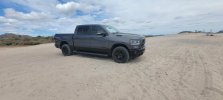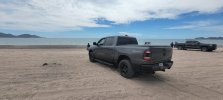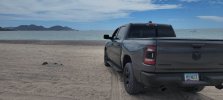JakePlissken
Member
- Joined
- Mar 21, 2024
- Messages
- 14
- Reaction score
- 5
- Points
- 3
- Age
- 37
Looking for insight here before taking the new truck on the beach. Either way, I’m taking it out there but looking for insight on what to expect.
For background. The truck I drove on the beaches for years was a 2013 F150 standard cab long bed 4x4 with 5.0 V8 equipped with 17” rims and 35” tires.
My truck now is a 2022 RAM Classic Warlock crew cab with 5.7 Hemi 4x4 with 275/60/20 tire and wheel combo. It’s all stock.
My concerns are my old truck was obviously lighter in weight, had more clearance and had a small rim size so I had larger sidewalls for airing down. I’m also still trying to wrap my head around “4 lock” as 4 HI and I’m thinking I’ll want to disable the MDS when on the beach. All things new to me that I never dealt with before.
The obvious questions here are:
1) airing down to 20psi ok on these larger rims and smaller tires without losing a bead?
2) thoughts on disabling MDS when beach driving?
3) is this heavier truck a dog in the sand? Anyone have first hand experience that can provide knowledge?
4) general thoughts on capabilities.
Also, bonus points to anyone who can suggest a good, economical, portable air compressor that can be used of the 115 volt power inverter in the truck.
Thanks in advance.
For background. The truck I drove on the beaches for years was a 2013 F150 standard cab long bed 4x4 with 5.0 V8 equipped with 17” rims and 35” tires.
My truck now is a 2022 RAM Classic Warlock crew cab with 5.7 Hemi 4x4 with 275/60/20 tire and wheel combo. It’s all stock.
My concerns are my old truck was obviously lighter in weight, had more clearance and had a small rim size so I had larger sidewalls for airing down. I’m also still trying to wrap my head around “4 lock” as 4 HI and I’m thinking I’ll want to disable the MDS when on the beach. All things new to me that I never dealt with before.
The obvious questions here are:
1) airing down to 20psi ok on these larger rims and smaller tires without losing a bead?
2) thoughts on disabling MDS when beach driving?
3) is this heavier truck a dog in the sand? Anyone have first hand experience that can provide knowledge?
4) general thoughts on capabilities.
Also, bonus points to anyone who can suggest a good, economical, portable air compressor that can be used of the 115 volt power inverter in the truck.
Thanks in advance.














